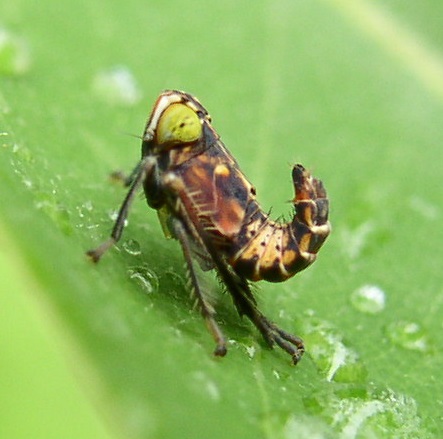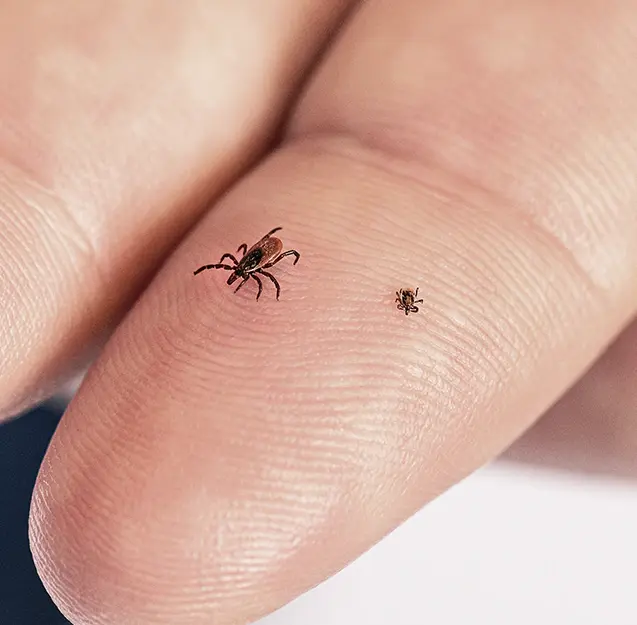|
Froghopper
The superfamily Cercopoidea, some members of which are called froghoppers and still others known as spittlebugs, are a group of hemipteran insects in the suborder Auchenorrhyncha. Adults are capable of jumping many times their height and length, giving the group their common name, but many species are best known for their plant-sucking nymphs which produce foam shelters, and are referred to as "spittlebugs". Taxonomy Traditionally, most of this superfamily was considered a single family, the Cercopidae, but this family has been split into three families for many years now: the Aphrophoridae, Cercopidae, and Clastopteridae. The tribe Epipygini was removed from the Aphrophoridae and elevated to family rank in 2001, but four subsequent phylogenies all showed this lineage was firmly nested within Aphrophoridae (e.g.Cryan, J.R., Svenson, G.J. (2010) Family-level relationships of the spittlebugs and froghoppers (Hemiptera: Cicadomorpha: Cercopoidea). Systematic Entomology, 35: 393-415 ... [...More Info...] [...Related Items...] OR: [Wikipedia] [Google] [Baidu] |
Cercopidae
Cercopidae are the largest family of Cercopoidea, a xylem-feeding insect group, commonly called froghoppers. They belong to the hemipteran suborder Auchenorrhyncha. A 2023 phylogenetic study of the family suggested the elevation of the New World subfamily Ischnorhininae to full family status as Ischnorhinidae, leaving a monophyletic Old World Cercopinae. Taxonomy Based on a 2023 molecular phylogenetic analysis, the Cercopidae ''senso stricto'' was divided into two monophyletic subfamilies, Cercopinae and Cosmoscartinae, each with a number of tribes. Cercopinae ;Tribe Bandusiini *''Bandusia (froghopper), Bandisia'' ;Tribe Callitetixini *''Abidama'' *''Callitettix'' *''Caloscarta'' *''Moultoniella'' *''Rhinastria'' *''Tadascarta'' ;Tribe Cercopini *''Cercopis'' *''Haematoloma'' *''Triecphorella'' ;Tribe Haematoscartini *''Clypeocarta'' *''Haematoscarta'' *''Lieftinckana'' *''Straelenia'' ;Tribe Hemiaufidini *''Hemiaufidus'' ;Tribe Locrisini *''Anyllis'' *''Duli ... [...More Info...] [...Related Items...] OR: [Wikipedia] [Google] [Baidu] |
Ischnorhinidae
Ischnorhinidae is the second largest family of Cercopoidea, a xylem-feeding insect group, formerly included in the family Cercopidae, and similarly commonly called froghoppers. Taxonomy They belong to the hemipteran suborder Auchenorrhyncha. A 2023 phylogenetic study of the superfamily indicated the elevation of the New World cercopid subfamily Ischnorhininae to full family status as Ischnorhinidae was necessaryin order to create a monophyletic Cercopidae, thereby now restricted exclusively to the Old World. This was based on the closer phylogenetic ties of Ischnorhinidae to Machaerotidae than to the remaining Cercopidae. The Cercopidae '' senso stricto'' was then divided into two monophyletic subfamilies, Cercopinae and Cosmoscartinae, each with a number of tribes. Tribes and genera Tribe Ischnorhinini *'' Baetkia'' *'' Choconta'' *'' Homalogrypota'' *'' Huaina'' *'' Iphirhina'' *'' Ischnorhina'' *'' Laccogrypota'' *'' Neolaccogrypota'' *'' Neosphenorhina'' *'' Sc ... [...More Info...] [...Related Items...] OR: [Wikipedia] [Google] [Baidu] |
Procercopidae
Procercopidae is an extinct family of froghoppers. They are known from the Early Jurassic to early Late Cretaceous of Eurasia. They are one of two main families of Mesozoic froghoppers alongside Sinoalidae. Procercopidae are considered to be the ancestral group from which modern froghoppers are derived. Taxonomy Chen et al, 2020 found that the family was paraphyletic with respect to extant froghoppers and the monotypic family Cercopionidae known from the Aptian aged Crato Formation of Brazil. * †'' Anomoscytina'' Ren et al. 1998 Yixian Formation, China, Aptian ** †''Anomoscytina anomala'' Ren et al. 1998 * †'' Anthoscytina'' Hong 1983 ** †''Anthoscytina brevineura'' Chen et al. 2015 Daohugou, China, Callovian ** †''Anthoscytina daica'' Shcherbakov 1988 Glushkovo Formation, Russia, Tithonian-Early Cretaceous ** †''Anthoscytina daidaleos'' Fu et al. 2018 Daohugou, China, Callovian ** †''Anthoscytina elegans'' Chen et al. 2015 Daohugou, China, Callovian ** †''An ... [...More Info...] [...Related Items...] OR: [Wikipedia] [Google] [Baidu] |
Sinoalidae
Sinoalidae is an extinct family of froghoppers known from the late Middle Jurassic to the early Late Cretaceous of Asia. They are one of two main Mesozoic families of froghoppers, alongside Procercopidae, unlike Procercopidae, Sinoalidae is thought to be an extinct side branch and not ancestral to modern froghoppers. Sinoalids have a temporally disjunct distribution being only known from the late Middle Jurassic (Callovian) Yanliao Biota of Inner Mongolia and the early Late Cretaceous (Cenomanian) aged Burmese amber of Myanmar, separated by over 60 million years. The family is "recognized by its tegmen with the costal area and clavus commonly more sclerotized and punctate than the remaining part, and its hind tibia with two rows of lateral spines" Genera Taxonomy based on Chen et al., 2019 * †'' Cretosinoala'' Fu and Huang 2019 Burmese amber, Myanmar, Cenomanian * †'' Hebeicercopis'' Hong 1983 Jiulongshan Formation, China, Callovian In the geologic timescale, the Callo ... [...More Info...] [...Related Items...] OR: [Wikipedia] [Google] [Baidu] |
Hemiptera
Hemiptera (; ) is an order of insects, commonly called true bugs, comprising more than 80,000 species within groups such as the cicadas, aphids, planthoppers, leafhoppers, assassin bugs, bed bugs, and shield bugs. They range in size from to around , and share a common arrangement of piercing-sucking mouthparts. The name "true bugs" is sometimes limited to the suborder Heteroptera. Entomologists reserve the term ''bug'' for Hemiptera or Heteroptera,Gilbert Waldbauer. ''The Handy Bug Answer Book.'' Visible Ink, 1998p. 1. which does not include other arthropods or insects of other orders such as ants, bees, beetles, or butterflies. In some varieties of English, all terrestrial arthropods (including non-insect arachnids and myriapods) also fall under the colloquial understanding of ''bug''. Many insects with "bug" in their common name, especially in American English, belong to other orders; for example, the lovebug is a fly and the Maybug and ladybug are beetles. ... [...More Info...] [...Related Items...] OR: [Wikipedia] [Google] [Baidu] |
Epipyginae
Epipyginae is a lineage of froghoppers in the insect family Aphrophoridae. There are at least three genera and about five described species in Epipyginae, found in the American tropics. In addition, there are more than 20 undescribed species in the group. Taxonomy All molecular analyses published since 2005 indicate that the group is monophyletic, but is clearly nested within the family Aphrophoridae The Aphrophoridae are a family of spittlebugs belonging to the order Hemiptera. There are at least 160 genera and 990 described species in Aphrophoridae. Taxonomy Traditionally, most of the superfamily Cercopoidea was considered a single fa ... and is probably best relegated to the status of a subfamily or tribe, rather than retained as a separate family, in order to keep Aphrophoridae as a monophyletic family.Cryan, J.R., Svenson, G.J. (2010) Family-level relationships of the spittlebugs and froghoppers (Hemiptera: Cicadomorpha: Cercopoidea). Systematic Entomology, 35: 393- ... [...More Info...] [...Related Items...] OR: [Wikipedia] [Google] [Baidu] |
Flea
Flea, the common name for the order (biology), order Siphonaptera, includes 2,500 species of small flightless insects that live as external parasites of mammals and birds. Fleas live by hematophagy, ingesting the blood of their hosts. Adult fleas grow to about long, are usually dark in color, and have bodies that are "flattened" sideways or narrow, enabling them to move through their hosts' fur or feathers. They lack wings; their hind legs are extremely well adapted for jumping. Their claws keep them from being dislodged, and their mouthparts are adapted for piercing skin and sucking blood. Some species can leap 50 times their body length, a feat second only to jumps made by another group of insects, the superfamily (taxonomy), superfamily of froghoppers. Flea larvae are worm-like, with no limbs; they have chewing mouthparts and feed on organic debris left on their hosts' skin. Genetic evidence indicates that fleas are a specialised lineage of parasitic scorpionflies (Mecopte ... [...More Info...] [...Related Items...] OR: [Wikipedia] [Google] [Baidu] |
Auchenorrhyncha
The Auchenorrhyncha suborder of the Hemiptera contains most of the familiar members of what was called the "Homoptera" – groups such as cicadas, leafhoppers, treehoppers, planthoppers, and spittlebugs. The aphids and scale insects are the other well-known "Homoptera", and they are in the suborder Sternorrhyncha. Distributed worldwide, all members of this group are plant-feeders, and many are vectors of viral and fungal diseases of plants. It is also common for Auchenorrhyncha species to produce either audible sounds or substrate vibrations as a form of communication. Such calls range from vibrations inaudible to humans, to the calls of many species of cicadas that can be heard for hundreds of metres, at least. In season, they produce the most characteristic and ubiquitous noise of the bush. Etymology The word "Auchenorrhyncha" is derived from the Greek words αὐχήν (auchēn), meaning "neck" or "throat," and ῥύγχος (rhynchos), meaning "snout". Classificat ... [...More Info...] [...Related Items...] OR: [Wikipedia] [Google] [Baidu] |
Nymph (biology)
In biology, a nymph (from Ancient Greek wikt:νύμφα, νύμφα ''nūmphē'' meaning "bride") is the juvenile (organism), juvenile form of some invertebrates, particularly insects, which undergoes gradual metamorphosis (biology), metamorphosis (hemimetabolism) before reaching its adult stage. Unlike a typical larva, a nymph's overall form already resembles that of the adult, except for a lack of wings (in winged species) and the emergence of genitalia. In addition, while a nymph ecdysis, moults, it never enters a pupal stage. Instead, the final moult results in an adult insect. Nymphs undergo multiple stages of development called instars. Taxa with nymph stages Many species of Arthropod, arthropods have nymph stages. This includes the insect orders such as Orthoptera (cricket (insect), crickets, grasshoppers and locusts), Hemiptera (cicadas, shield bugs, Whitefly, whiteflies, aphids, leafhoppers, froghoppers, treehoppers), mayfly, mayflies, termites, cockroaches, mantises, ... [...More Info...] [...Related Items...] OR: [Wikipedia] [Google] [Baidu] |
Prosapia Bicincta
''Prosapia bicincta'', the two-lined spittlebug, is a species of insect in the family Ischnorhinidae (formerly Cercopidae). Adults are black with two red or orange lines crossing the wings. It reaches a length of 8–10 mm. It is widespread in the eastern half of the United States. A similar species, ''Prosapia simulans'', can be found throughout Central America where it is considered an agricultural pest. Nymphs feed on various grasses (including Eremochloa ophiuroides, centipedegrass, Cynodon, bermudagrass and corn) from within foam (consisting of their own spittle) produced from juices of their host plant. Adults feed on the leaves of both native and introduced species of holly, as well as on the leaves of the Cercis canadensis, eastern redbud tree. It is a pest of forage grasses and turf grasses such as those grown for lawns and its consumption of these plants causes economic damage throughout the southeastern United States. Since 2016, ''P. bicincta'' has been assoc ... [...More Info...] [...Related Items...] OR: [Wikipedia] [Google] [Baidu] |
Leafhopper
Leafhopper is the common name for any species from the family (biology), family Cicadellidae: based on the type genus ''Cicadella''. These minute insects, colloquially known as hoppers, are plant feeders that suck plant sap from grass, shrubs, or trees. Their hind legs are modified for jumping, and are covered with hairs that facilitate the spreading of a secretion over their bodies that acts as a water repellent and carrier of pheromones. They undergo a partial metamorphosis, and have various host associations, varying from very generalized to very specific. Some species have a cosmopolitan distribution, or occur throughout the temperate and tropical regions. Some are pests or Vector (epidemiology), vectors of plant viruses and phytoplasmas. The family is distributed all over the world, and constitutes the second-largest hemipteran family, with at least 20,000 described species. They belong to a lineage traditionally treated as infraorder Cicadomorpha in the suborder Auchenorrhy ... [...More Info...] [...Related Items...] OR: [Wikipedia] [Google] [Baidu] |








